Abstract
It is generally accepted that most patients with Clostridium difficile-associated diarrhoea acquire the organism from the environment. Recently we demonstrated that household pets may constitute a significant reservoir of C. difficile through gastrointestinal carriage in up to 39% of cats and dogs. These findings suggested that direct transmission from household pets, or contamination of the environment by them, may be a factor in the pathogenesis of C. difficile-associated diarrhoea. To investigate this possibility, we examined isolates of C. difficile from humans, pets and the environment by restriction enzyme analysis (REA) and restriction fragment length polymorphism (RFLP) typing using enhanced chemiluminescence. Both REA and RFLP typing methods used Hind III digests of chromosomal DNA. A total of 116 isolates of C. difficile from pets (26), veterinary clinic environmental sites (33), humans (37) and hospital environmental sites (20) was examined. REA was far more discriminatory than RFLP typing and for all isolates there were 34 REA types versus 6 RFLP types. There was good correlation between the REA types found in isolates from pets and from the veterinary clinic environment, and between isolates from humans and from those found in the hospital environment. There was, however, no correlation between REA type of C. difficile found in pets and isolates of human origin. We conclude that there may still be a risk of humans acquiring C. difficile from domestic pets as these findings may be the result of geographical variation.
Full text
PDF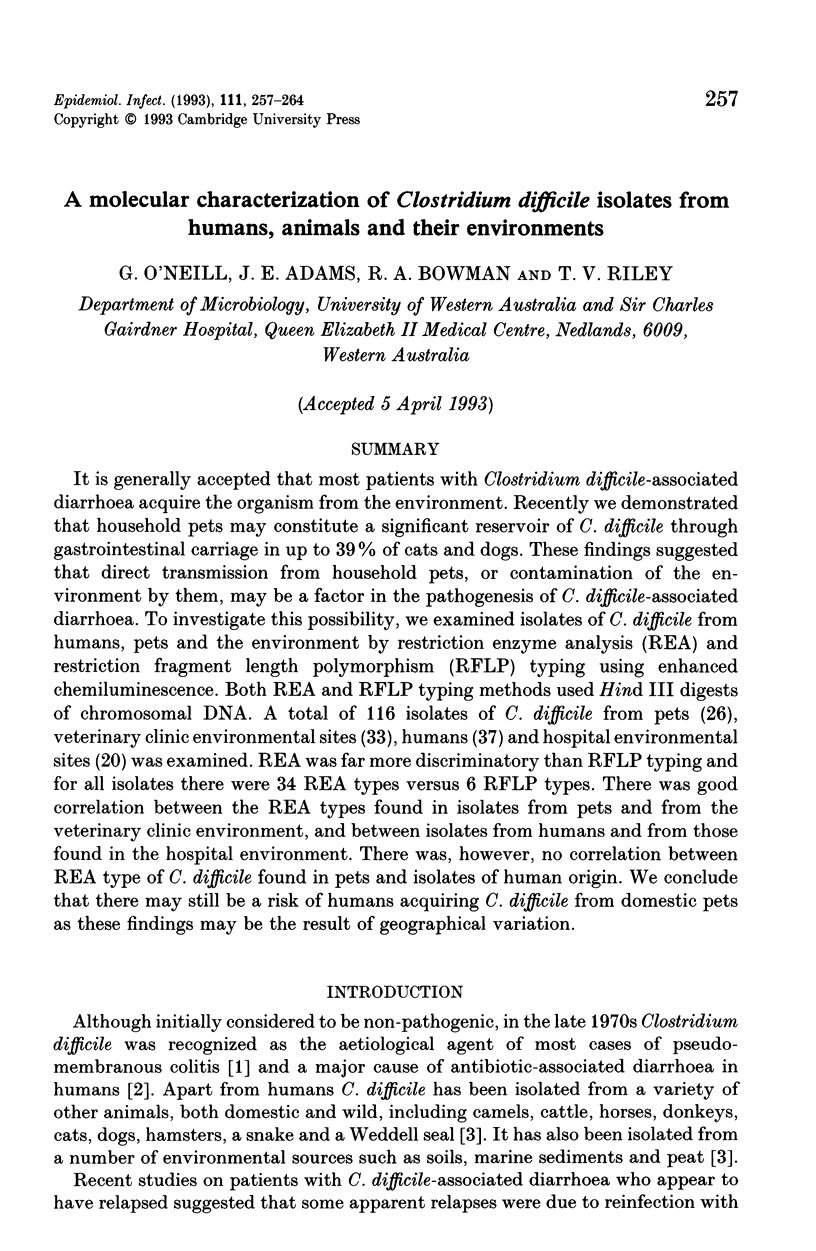
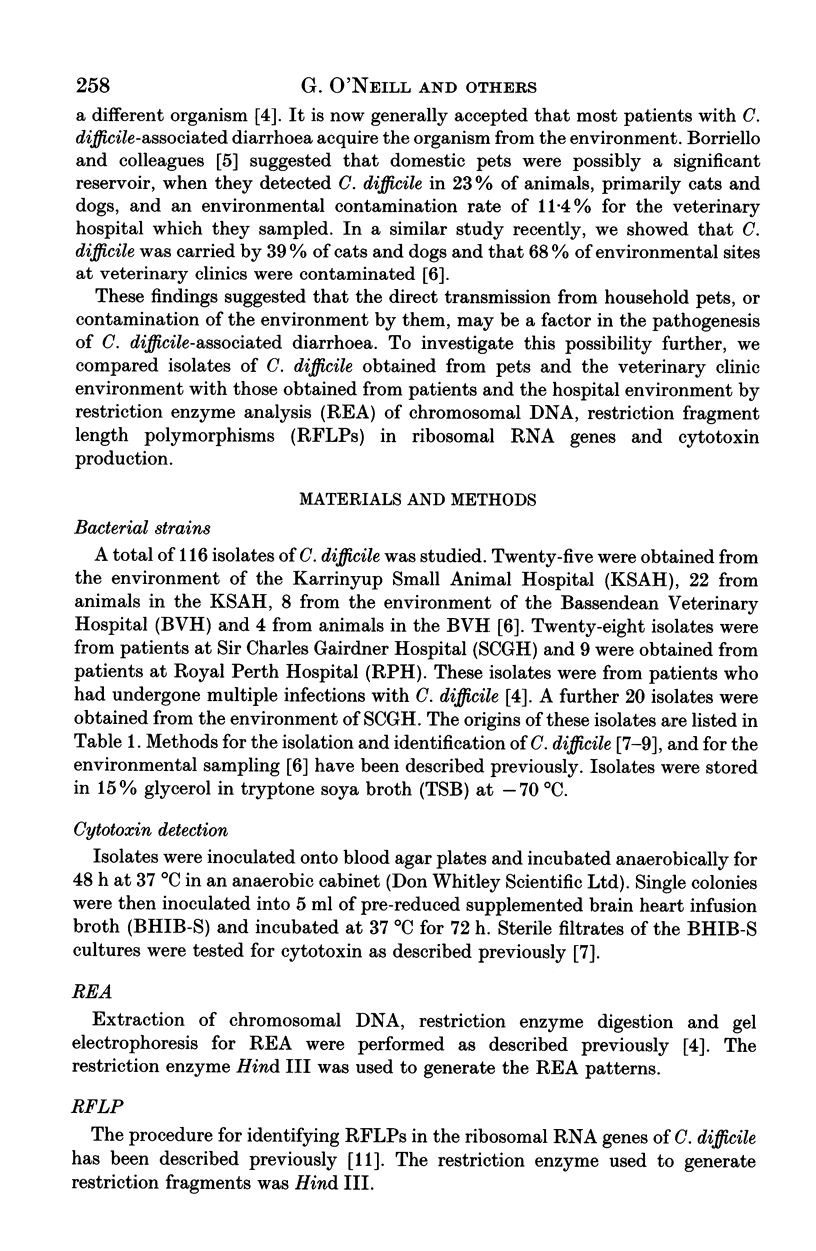
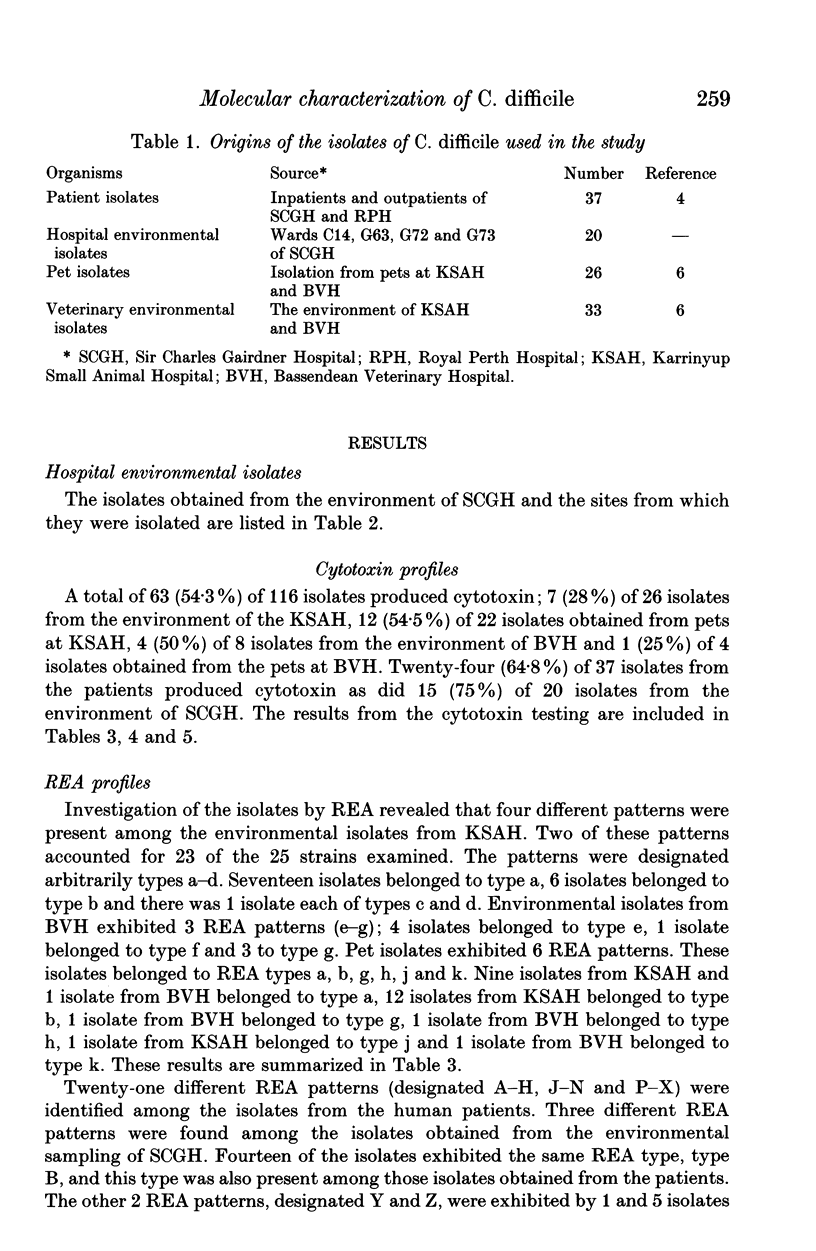
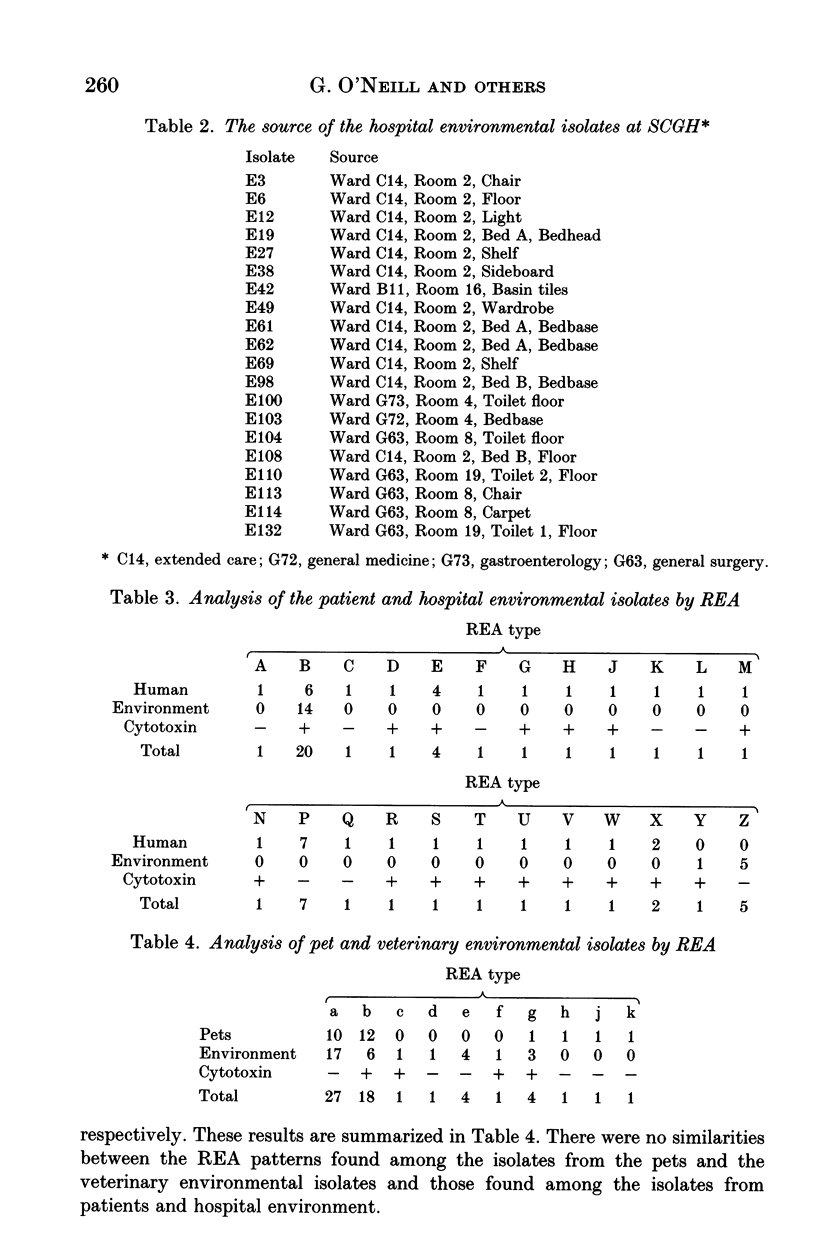
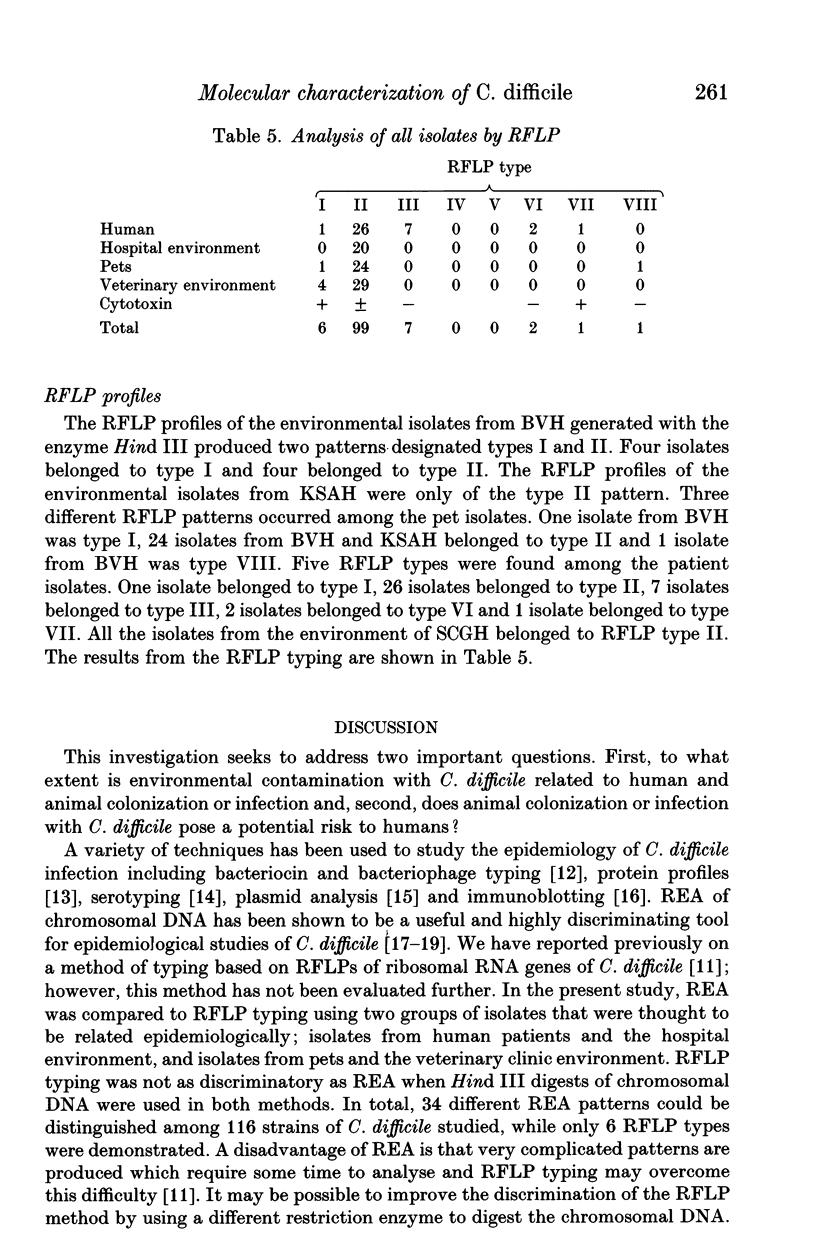
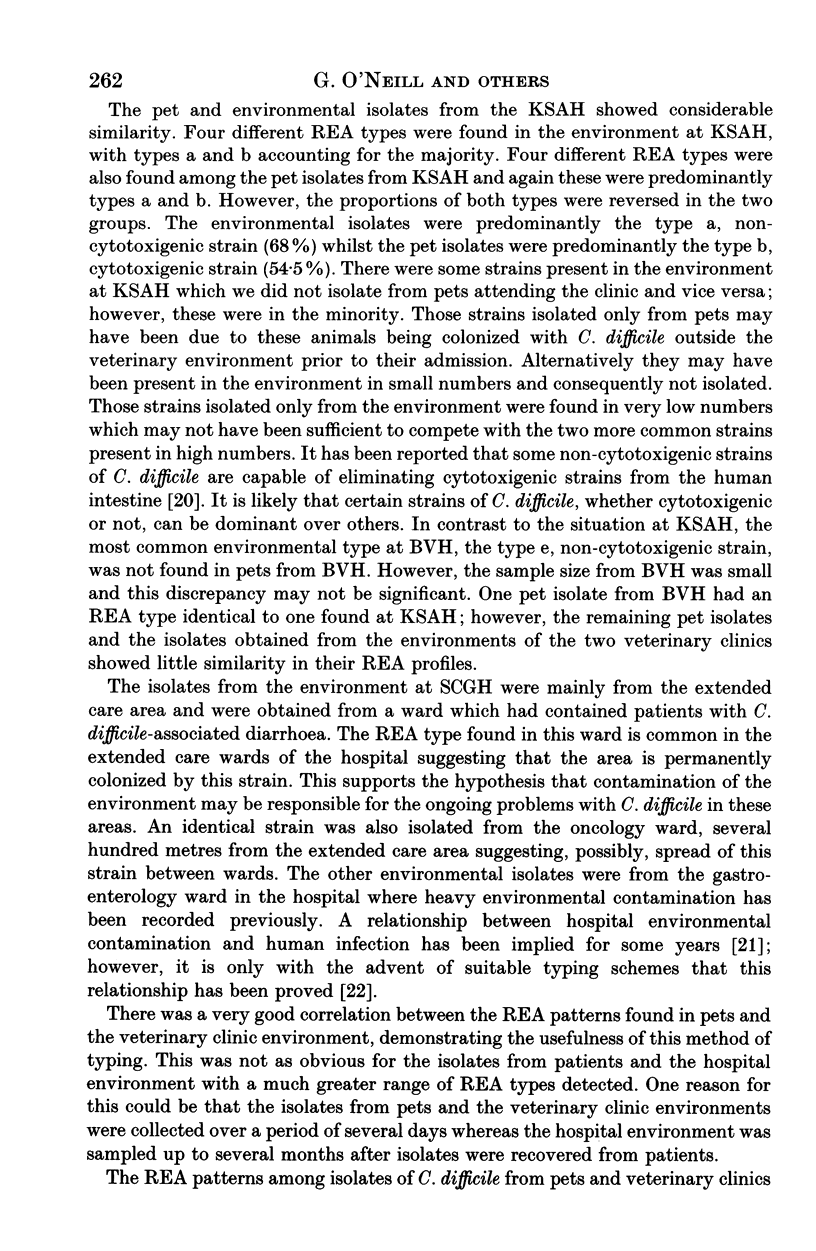
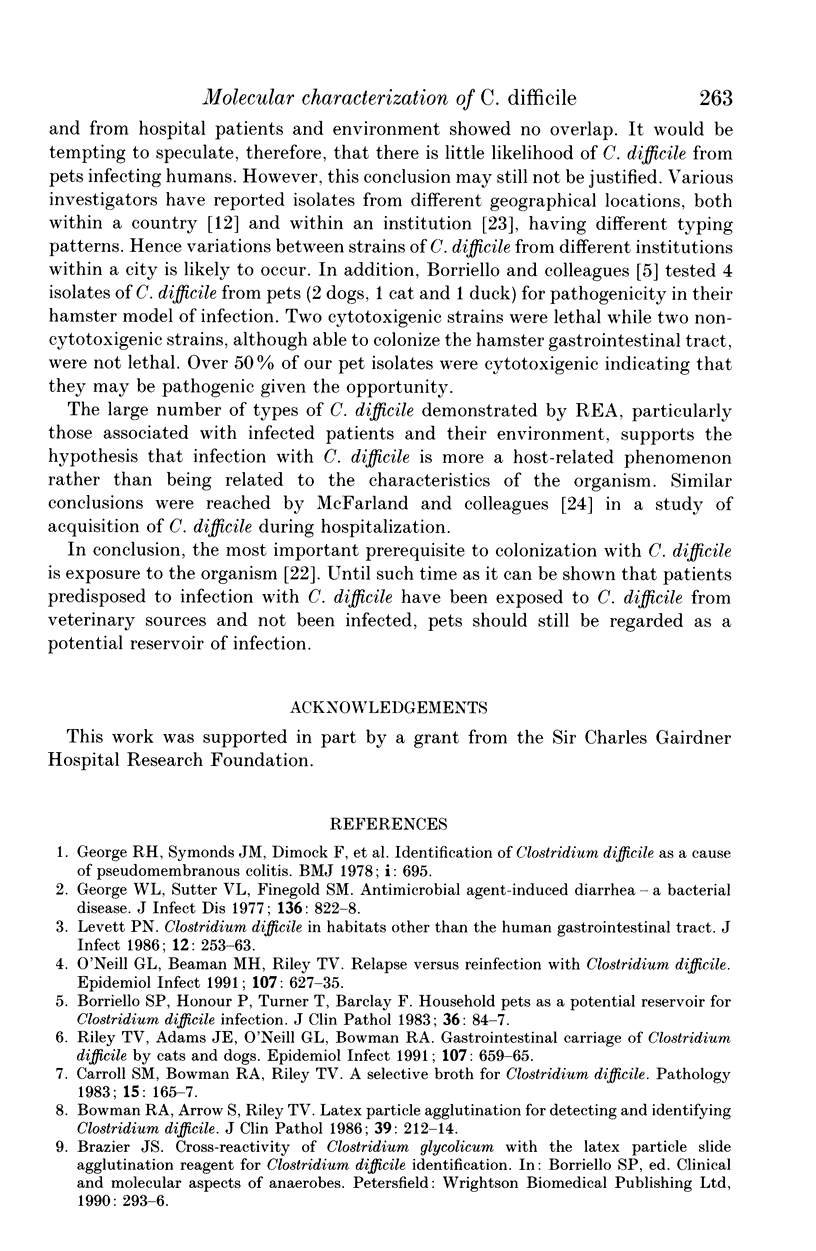
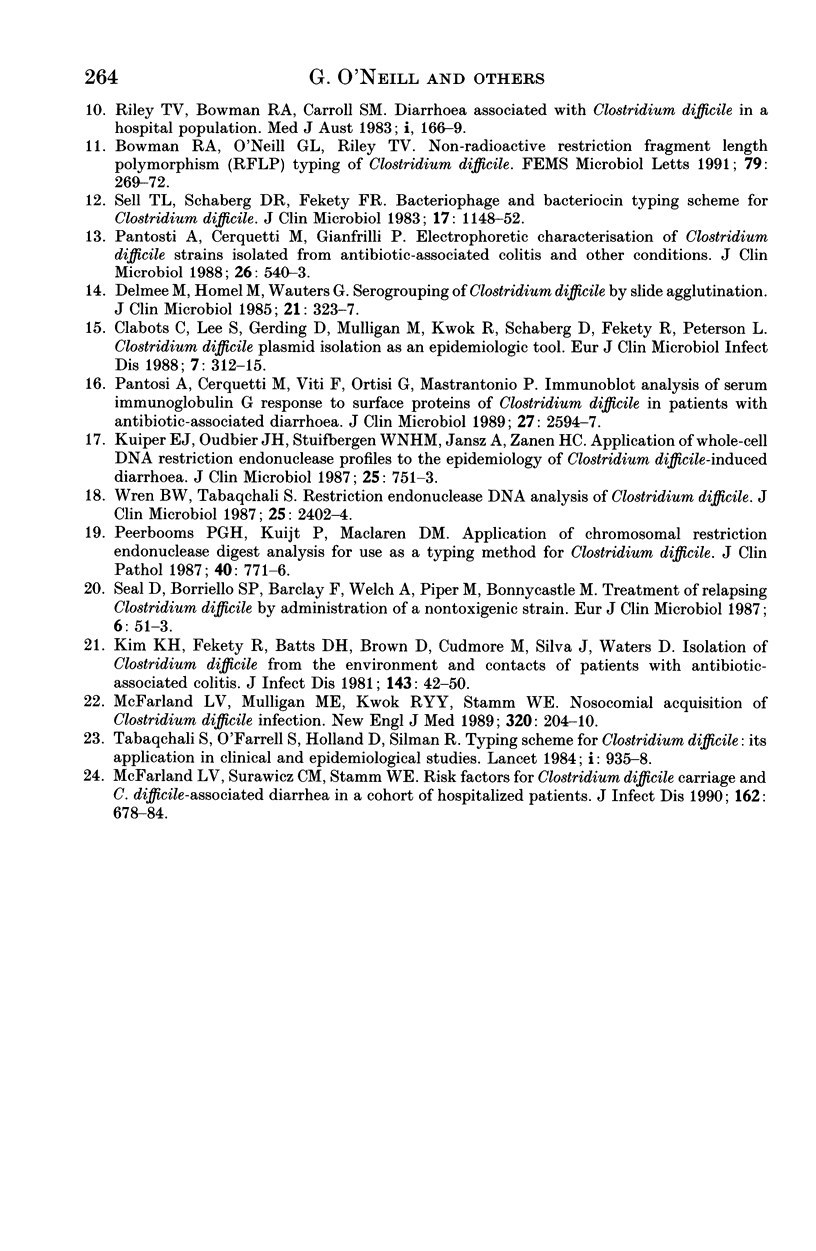
Selected References
These references are in PubMed. This may not be the complete list of references from this article.
- Borriello S. P., Honour P., Turner T., Barclay F. Household pets as a potential reservoir for Clostridium difficile infection. J Clin Pathol. 1983 Jan;36(1):84–87. doi: 10.1136/jcp.36.1.84. [DOI] [PMC free article] [PubMed] [Google Scholar]
- Bowman R. A., Arrow S. A., Riley T. V. Latex particle agglutination for detecting and identifying Clostridium difficile. J Clin Pathol. 1986 Feb;39(2):212–214. doi: 10.1136/jcp.39.2.212. [DOI] [PMC free article] [PubMed] [Google Scholar]
- Bowman R. A., O'Neill G. L., Riley T. V. Non-radioactive restriction fragment length polymorphism (RFLP) typing of Clostridium difficile. FEMS Microbiol Lett. 1991 Apr 15;63(2-3):269–272. doi: 10.1016/0378-1097(91)90097-t. [DOI] [PubMed] [Google Scholar]
- Carroll S. M., Bowman R. A., Riley T. V. A selective broth for Clostridium difficile. Pathology. 1983 Apr;15(2):165–167. doi: 10.3109/00313028309084706. [DOI] [PubMed] [Google Scholar]
- Clabots C., Lee S., Gerding D., Mulligan M., Kwok R., Schaberg D., Fekety R., Peterson L. Clostridium difficile plasmid isolation as an epidemiologic tool. Eur J Clin Microbiol Infect Dis. 1988 Apr;7(2):312–315. doi: 10.1007/BF01963112. [DOI] [PubMed] [Google Scholar]
- Delmee M., Homel M., Wauters G. Serogrouping of Clostridium difficile strains by slide agglutination. J Clin Microbiol. 1985 Mar;21(3):323–327. doi: 10.1128/jcm.21.3.323-327.1985. [DOI] [PMC free article] [PubMed] [Google Scholar]
- George R. H., Symonds J. M., Dimock F., Brown J. D., Arabi Y., Shinagawa N., Keighley M. R., Alexander-Williams J., Burdon D. W. Identification of Clostridium difficile as a cause of pseudomembranous colitis. Br Med J. 1978 Mar 18;1(6114):695–695. doi: 10.1136/bmj.1.6114.695. [DOI] [PMC free article] [PubMed] [Google Scholar]
- George W. L., Sutter V. L., Finegold S. M. Antimicrobial agent-induced diarrhea--a bacterial disease. J Infect Dis. 1977 Dec;136(6):822–828. doi: 10.1093/infdis/136.6.822. [DOI] [PubMed] [Google Scholar]
- Kim K. H., Fekety R., Batts D. H., Brown D., Cudmore M., Silva J., Jr, Waters D. Isolation of Clostridium difficile from the environment and contacts of patients with antibiotic-associated colitis. J Infect Dis. 1981 Jan;143(1):42–50. doi: 10.1093/infdis/143.1.42. [DOI] [PubMed] [Google Scholar]
- Kuijper E. J., Oudbier J. H., Stuifbergen W. N., Jansz A., Zanen H. C. Application of whole-cell DNA restriction endonuclease profiles to the epidemiology of Clostridium difficile-induced diarrhea. J Clin Microbiol. 1987 Apr;25(4):751–753. doi: 10.1128/jcm.25.4.751-753.1987. [DOI] [PMC free article] [PubMed] [Google Scholar]
- Levett P. N. Clostridium difficile in habitats other than the human gastro-intestinal tract. J Infect. 1986 May;12(3):253–263. doi: 10.1016/s0163-4453(86)94294-5. [DOI] [PubMed] [Google Scholar]
- McFarland L. V., Mulligan M. E., Kwok R. Y., Stamm W. E. Nosocomial acquisition of Clostridium difficile infection. N Engl J Med. 1989 Jan 26;320(4):204–210. doi: 10.1056/NEJM198901263200402. [DOI] [PubMed] [Google Scholar]
- McFarland L. V., Surawicz C. M., Stamm W. E. Risk factors for Clostridium difficile carriage and C. difficile-associated diarrhea in a cohort of hospitalized patients. J Infect Dis. 1990 Sep;162(3):678–684. doi: 10.1093/infdis/162.3.678. [DOI] [PubMed] [Google Scholar]
- O'Neill G. L., Beaman M. H., Riley T. V. Relapse versus reinfection with Clostridium difficile. Epidemiol Infect. 1991 Dec;107(3):627–635. doi: 10.1017/s0950268800049323. [DOI] [PMC free article] [PubMed] [Google Scholar]
- Pantosti A., Cerquetti M., Gianfrilli P. M. Electrophoretic characterization of Clostridium difficile strains isolated from antibiotic-associated colitis and other conditions. J Clin Microbiol. 1988 Mar;26(3):540–543. doi: 10.1128/jcm.26.3.540-543.1988. [DOI] [PMC free article] [PubMed] [Google Scholar]
- Pantosti A., Cerquetti M., Viti F., Ortisi G., Mastrantonio P. Immunoblot analysis of serum immunoglobulin G response to surface proteins of Clostridium difficile in patients with antibiotic-associated diarrhea. J Clin Microbiol. 1989 Nov;27(11):2594–2597. doi: 10.1128/jcm.27.11.2594-2597.1989. [DOI] [PMC free article] [PubMed] [Google Scholar]
- Peerbooms P. G., Kuijt P., Maclaren D. M. Application of chromosomal restriction endonuclease digest analysis for use as typing method for Clostridium difficile. J Clin Pathol. 1987 Jul;40(7):771–776. doi: 10.1136/jcp.40.7.771. [DOI] [PMC free article] [PubMed] [Google Scholar]
- Riley T. V., Adams J. E., O'Neill G. L., Bowman R. A. Gastrointestinal carriage of Clostridium difficile in cats and dogs attending veterinary clinics. Epidemiol Infect. 1991 Dec;107(3):659–665. doi: 10.1017/s0950268800049359. [DOI] [PMC free article] [PubMed] [Google Scholar]
- Riley T. V., Bowman R. A., Carroll S. M. Diarrhoea associated with Clostridium difficile in a hospital population. Med J Aust. 1983 Feb 19;1(4):166–169. doi: 10.5694/j.1326-5377.1983.tb104346.x. [DOI] [PubMed] [Google Scholar]
- Seal D., Borriello S. P., Barclay F., Welch A., Piper M., Bonnycastle M. Treatment of relapsing Clostridium difficile diarrhoea by administration of a non-toxigenic strain. Eur J Clin Microbiol. 1987 Feb;6(1):51–53. doi: 10.1007/BF02097191. [DOI] [PubMed] [Google Scholar]
- Sell T. L., Schaberg D. R., Fekety F. R. Bacteriophage and bacteriocin typing scheme for Clostridium difficile. J Clin Microbiol. 1983 Jun;17(6):1148–1152. doi: 10.1128/jcm.17.6.1148-1152.1983. [DOI] [PMC free article] [PubMed] [Google Scholar]
- Tabaqchali S., Holland D., O'Farrell S., Silman R. Typing scheme for Clostridium difficile: its application in clinical and epidemiological studies. Lancet. 1984 Apr 28;1(8383):935–938. doi: 10.1016/s0140-6736(84)92392-4. [DOI] [PubMed] [Google Scholar]
- Wren B. W., Tabaqchali S. Restriction endonuclease DNA analysis of Clostridium difficile. J Clin Microbiol. 1987 Dec;25(12):2402–2404. doi: 10.1128/jcm.25.12.2402-2404.1987. [DOI] [PMC free article] [PubMed] [Google Scholar]


